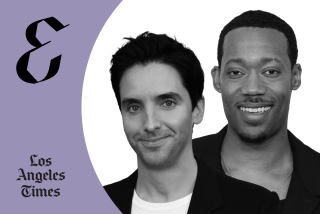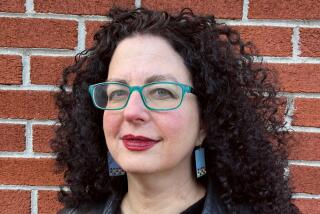‘Sleepy Hollow,’ ‘Opposite Worlds,’ more connect on Twitter
In Syfy’s reality competition “Opposite Worlds,” Twitter put unprecedented power in the hands of viewers, supplying them with the ability to reward popular contestants with a luxurious spa day while punishing others with a less savory task: cleaning human excrement.
The little blue birdie has fluttered into the writers room on Fox’s “Sleepy Hollow,” inspiring one episode to address viewers’ dismay, voiced loudly on Twitter, over the central character’s Revolutionary War era attire. For a humorous few moments, Ichabod Crane doffs his period costume for a pair of uncomfortably contemporary skinny jeans.
These shows are just a sample of the sorts of experimentation being done as network executives and producers navigate social media (and interactivity) to attract viewers to the living room TV and keep them engaged. About one-third of all prime-time shows employ some Twitter element — from NBC’s “The Voice,” which lets viewers turn to Twitter to “save” performers whom judges have eliminated, to ABC’s “Scandal,” whose actors converse online with viewers as each episode is telecast. Just last week, Twitter cemented its reputation as TV’s favorite follower during the Oscar telecast when host Ellen Degeneres’ star-studded “selfie” set a record for most retweets.
In a nutshell: @Twitter is #trendingwithTV more than ever b4.
WINTER TV PREVIEW: Full coverage of the season’s shows
“What has popped up in the last five years is TV viewers have a connection to show runners and actors that is more immediate and transparent,” said Geoffrey Long, who explores transmedia experiences for USC’s Annenberg Innovation Lab. “There’s an active dialogue that is no longer heavily one-sided. We’re still in the early stages of how that changes things.”
The social network has carefully cultivated the Twitter-TV association. The San Francisco company forged a partnership with Nielsen to produce ratings based on the audience for TV-related conversations. It struck partnerships with major networks, including CBS, NBC, Fox and ESPN as well as with sports leagues. Advertisers similarly have jumped into Twitter’s nest, with major brands including Budweiser, Coca-Cola, Doritos, Honda and H&M all incorporating Twitter hashtags as part of their Super Bowl ad campaigns.
“It’s past experimental for many agencies. It’s proven to drive engagement at scale,” said Mike Margolin, senior vice president of audience strategy for Santa Monica-based RPA, Honda’s ad agency.
Twitter’s head of television, Fred Graver, said 85% of the network shows that premiered last fall were accompanied by live tweeting, and 30% to 40% of prime-time shows continue to maintain a presence on the social network. Hashtags, those short phrases that follow a pound sign, are plastered on corners of the TV screen, not-so-subtly guiding viewers on their episodic tweeting adventure.
BEST TV OF 2013 Lloyd | McNamara
Television network executives have sought to reach viewers on a variety of social media platforms, from Facebook to visually oriented sites such as Instagram and Pinterest. With some 241 million people using Twitter each month, networks have been encouraging actors such as Sarah Michelle Gellar of CBS’ “The Crazy Ones” and Natasha Lyonne of Netflix’s “Orange Is the New Black” to join the digital bandwagon to help build buzz; of course, not everyone has given way to peer pressure (some holdouts: Andy Samberg of Fox’s “Brooklyn Nine-Nine,” the cast of NBC’s “The Blacklist”).
Misha Collins, who plays the angel Castiel on the long-running CW drama “Supernatural,” said social media has contributed to the show’s longevity. He said Jared Padalecki and Jensen Ackles, who play brothers following in their father’s footsteps as demon hunters, cultivated a connection with fans when the show premiered in 2005.
“Jared and Jensen started going to fan conventions early on. It fed this live interaction with the fans,” said Collins, who has amassed a following of 1.3 million people on Twitter. “When I came on, I started a Twitter account. That sort of moved that live interaction into the virtual environment.”
And it’s not just the stars — the creative minds behind TV’s most popular shows have awoken from their deep slumber to the sound of the chirping. Some writers rooms have adopted Twitter accounts to engage with viewers, cognizant of its pervasiveness and how it applies to 21st century storytelling.
PHOTOS: Faces to watch 2014 | TV
“It’s become an essential part of our storytelling and our shows,” said Alex Kurtzman, executive producer of Fox’s supernatural drama “Sleepy Hollow.” “There [once was] a distinction between that thing that used to be off to the side, and other people handled, and the way we’re actually breaking stories in the room for the episodes that air on television. It’s all part of the same process now.”
The show’s writers take turns tweeting during each broadcast, opening the door to the writers room and giving viewers insights into story choices and character motivation. The writers pay attention to fan discussions — and in some cases, have introduced plot elements in response to comments about the show, a modern retelling of Washington Irving’s “The Legend of Sleepy Hollow.”
Crane’s appearance in skinny jeans was a signal to the viewers that the writers were paying attention to their comments. “We all felt very strongly that it’s like asking Superman to take off his cape. Then he’s not Superman,” Kurtzman said. “But there were so many people online who had so much to say about his clothes, we sat down in the writers room and tried to come up with creative ways to address those concerns.”
The backlash on Twitter and on other online platforms was part of what prompted “The Good Wife” writers to wrap up more quickly a story line involving Kalinda (Archie Punjabi) and her mysterious estranged husband in Season 4. When two characters on ABC Family’s “Pretty Little Liars” — Emily and Maya — broke up, fans of that union gathered online to orchestrate a protest and sent 10,000 pink pens to the writers.
“They said to write Maya back into the show,” King recalled. “Although we couldn’t do that for various reasons, we did let them know we heard them.” A subsequent episode features a scene where a stack of those pens made a cameo.
Long foresees a day when the format of the medium — 140 or fewer characters — influences how beats of a story are told.
“I think what we’re going to see more and more of, are TV writers thinking and writing in ways that lend themselves to quotability and spreadability?” he said.
The evolution to that has already begun.
“Mob City” creator Frank Darabont adapted the script for the TNT miniseries pilot to Twitter, telling the story through a series of tweets that began with the opening moments, “Open on the exterior of a New York City street at night.”
But not everyone is sold on drinking from the digital water cooler.
CRITICS’ PICKS: What to watch, where to go, what to eat
Scott Gimple, show runner and executive producer of AMC powerhouse “The Walking Dead,” is cautious about giving too much power to the thumb-to-text chatter. A feat that requires discipline considering the zombie drama consistently dominates Twitter-related activities during its first-run episodes, with creative episode-specific hashtags mentioned on commercial breaks and during the companion show, “The Talking Dead.”
“You’ll see a tweet that’s like, ‘Ugh! This show is so boring,’ and filtering in right after it is one that’s like ‘That scene had me on the edge of my seat!’” Gimple said. “It’s a very popular show and people have all sorts of opinions, and their opinions are valid, and their opinions are theirs.... But you can’t go in trying to serve that one guy who said that or this girl that said this. That’s a slippery slope.”
Reality shows, particularly competitions such as “American Idol” and “The Bachelor,” tend to lend themselves naturally to online conversations. As do larger-than-life dramas like HBO’s “Game of Thrones” or soapy dramas like “Scandal,” a political thriller in which actress Kerry Washington plays a former White House communications director who runs a crisis management firm while maintaining a torrid affair with the president.
In a twist, the medium that has become a tool for comedians to experiment with jokes has, in some ways, proved to be a challenge when it comes to being a tool for TV comedies. The format still allows for pre-show buildup in the form of sharing memes or teasers, but when it comes to live-tweeting, things get tricky.
“It’s a weird thing because you don’t want to miss a joke,” said Ike Barinholtz, a cast member and writer for “The Mindy Project.” “It’s one of those things where maybe you tweet during a commercial break about whatever made you laugh.”
PHOTOS: Celebrities by The Times
The Syfy network found itself caught up in the conversational tsunami that is Twitter last summer with the release of the made-for-TV disaster movie “Sharknado.” The New York Daily News published an image from the film, sparking a social media phenomenon that, at one point, produced more than 5,000 tweets per minute. Health and Human Services Secretary Kathleen Sebelius weighed in with a tweet, noting the injuries would be covered under Obamacare.
The network tried tro harness that power with its recently concluded “Opposite Worlds,” which incorporated social media into its premise. It factored into the selection of the show’s host, Luke Tipple, who has more than 136,000 followers on Twitter.
Participation on the social media platform was a central element of the show, in which two teams shared a house divided into different environments — one which boasted all the trappings of contemporary civilization, while the other was set in the Stone Age — and competed for a shot at a $100,000 grand prize.
Syfy hired Georgetown University Yahoo Fellow in Residence Kalev H. Leetaru to analyze Twitter conversations in real time to produce a leader board that dynamically ranked the contestants, based on their popularity. It was a sophisticated task that involved recognizing tweets that contained any of 100 hashtags and extracted the meaning of viewer comments that may contain abbreviations, slang and misspellings.
In a page borrowed from “The Hunger Games,” viewers went online to choose rewards and punishments for the most and least popular participants.
“The object of the exercise [was] to create urgent, appointment viewing,” Syfy President Dave Howe said of the network’s first reality show. “It becomes that much more urgent, because, in terms of the social media and the storytelling, you have to be in on it at the time it’s happening, otherwise you’re really out of touch with what’s been going on.”
More to Read
The complete guide to home viewing
Get Screen Gab for everything about the TV shows and streaming movies everyone’s talking about.
You may occasionally receive promotional content from the Los Angeles Times.







